 |
 |
 |
| |
Dynamics of emergence of CXCR4-using HIV in clinical samples as detected by Trofile and MT-2 assays
|
| |
| |
Reported by Jules Levin
XVII HIV Drug resistance Workshop
June 2008
Sitges, Spain
Angelique B. van 't Wout1, Eoin Coakley2, Jacqueline Reeves2, Wei Huang2, Chris J. Petropoulos2and Hanneke Schuitemaker1
1Department of Experimental Immunology, Center for Infectious Diseases and Immunity Amsterdam (CINIMA), Academic Medical Center, University of Amsterdam, Amsterdam, The Netherlands. 2Monogram Biosciences, Clinical Research, South San Francisco, USA
AUTHOR CONCLUSIONS
The detection of X4 variants in patient plasma (enhanced Trofile) or PBMC (MT-2 assay) is highly concordant.
Levels of X4 variants near the level of detection of both assays around the time of first detection may account for their detection about 3 months earlier or later on repeated testing.
Clonal analysis revealed distinct phenotypes of dual-tropic variants possibly representing Env with different efficiencies of CXCR4 usage during evolution from the R5 to X4 phenotype.
ABSTRACT
We evaluated the performance of the Trofile and MT-2 assays to detect X4 variants directly in patient PBMC and plasma.
In patients with a known moment of first X4 detection by MT-2 assay, a switch from R5 to dual/mixed tropism (DM) was detected at or before this moment in 5/10 patients by standard Trofile and in 9/10 patients by enhanced Trofile.
We also compared results with the outcome of Trofile and MT-2 assays on molecular and biological clones isolated from the same samples.
Clonal analysis of both plasma and PBMC samples showed fluctuating levels of emerging CXCR4-using clones, all of which also used CCR5.
The relative ability to use CXCR4 varied between efficient CXCR4 use (designated dual-X clones) and poor CXCR4 use (designated dual-R clones).
The detection of X4 variants in patient plasma (enhanced Trofile) or PBMC (MT-2 assay) is highly concordant.
Clonal analysis revealed distinct phenotypes of dual-tropic variants possibly representing Env with different efficiencies of CXCR4 usage during evolution from the R5 to X4 phenotype.
INTRODUCTION
The recent availability of CCR5 antagonists as anti-HIV therapeutics has highlighted the need to identify CXCR4-using (X4) variants in patient samples when considering use of this new drug class. Various assays exist to detect X4 variants. We previously reported that in HIV-1 isolates the tropism profiles by the MT-2 and Trofile assays demonstrate high concordance (93%-95%). Moreover, in patients with a known moment of first X4 detection by MT-2 assay, a switch from R5 to dual/mixed tropism (DM) was also detected by Trofile assay. Here, we further evaluated the performance of the Trofile and MT-2 assays to detect X4 variants directly in patient PBMC and plasma and compared results with the outcome of Trofile and MT-2 assays on molecular and biological clones isolated from the same samples.
METHODS
Samples were derived from participants of the Amsterdam Cohort Studies on HIV/AIDS who underwent consecutive tropism testing by the Trofile and MT-2 assays at approximately 3 monthly intervals. In the MT2 assay, 1 million patient PBMC are co-cultured with 1 million MT-2 cells for 4 weeks with biweekly CPE screening and passaging (Figure 1). In the Trofile assay, HIV envis amplified from 1 mLof patient plasma and tested in a recombinant phenotypingassay (Figure 2).
We evaluated multiple time points per patient that were temporally related to the first detection of X4 variants by the MT-2 assay. Clonal composition of patient PBMC samples was determined using limiting dilution biological cloning on uninfected PHA-stimulated PBMC. In addition, multiple Envclones were isolated from longitudinal plasma samples to allow tropism testing and sequence analysis.

RESULTS
For 10 patients with documented emergence of X4 variants in the MT-2 assay, plasma samples were tested in both the standard and enhanced Trofile assay. In 4 patients the MT-2 assay was also repeated. Figure 3 shows representative results for 6 of the 10 patients.
Figure 3. Original and repeat MT2 and standard and enhanced Trofile assay results for corresponding PBMC and plasma samples from 6 of 10 patients studied with X4 emergence. For each patient top graph represents MT2 assay results, second graph represents Trofile scores, third graphs represents Trofile RLU scores and bottom graphs represents results for plasma clones.
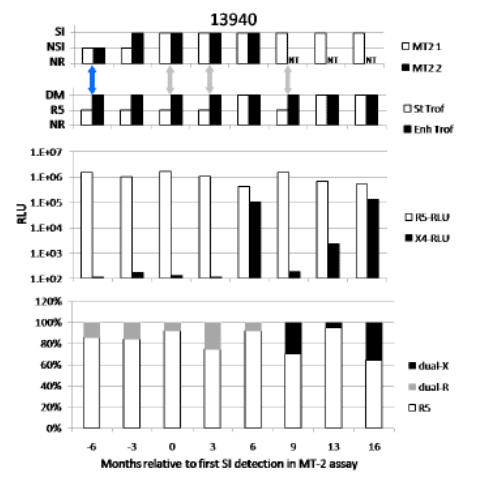
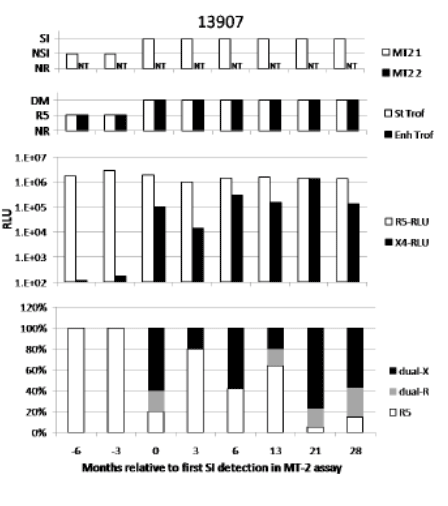
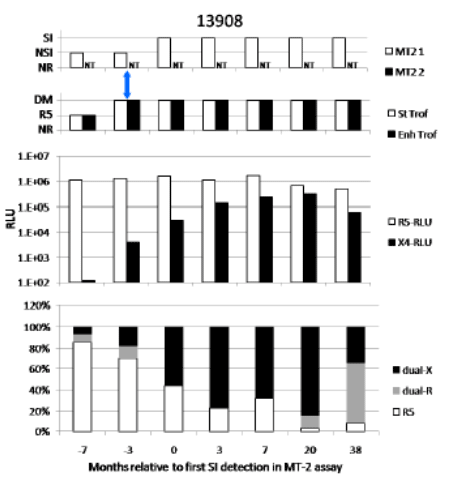
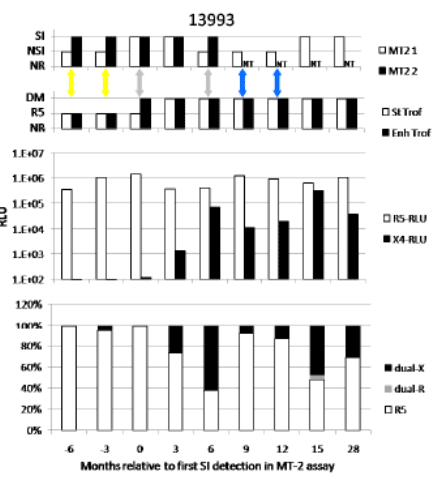

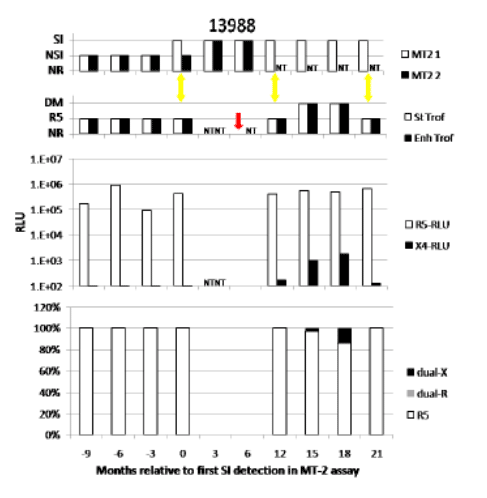
RESULTS -2-
In patients with a known moment of first X4 detection by MT-2 assay, a switch from R5 to dual/mixed tropism (DM) was detected at or before this moment in 5/10 patients by standard Trofile and in 9/10 patients by enhanced Trofile. Table 3 summarizes the first detection of X4 virus for each of the assays tested. Limiting dilution biological cloning using up to 4 million patient PBMC revealed low level presence of X4 variants 3 months before their detection in MT-2 assay in 2/20 patients (Table 4). In 80 samples from 20 patients who never showed emergence of X4 variants by MT2 assay, also no X4 variants were detected when larger numbers of patient PBMC were used for limiting dilution biological cloning (Table 5).
Clonal analysis of both plasma and PBMC samples showed fluctuating levels of emerging CXCR4-using clones, all of which also used CCR5. In plasma, the relative ability to use CXCR4 varied between efficient CXCR4 use (designated dual-X clones, detected in all patients) and poor CXCR4 use (designated dual-R clones, detected prior to or concurrent with detection of dual-X clones in 7 of 9 patients) (Figure 3, bottom panels for each patient). The same was observed for biological clones obtained from PBMC samples (data not shown).
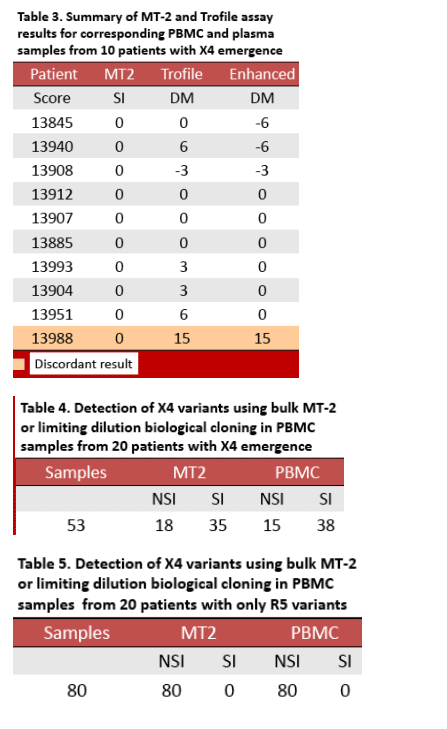
|
| |
|
 |
 |
|
|